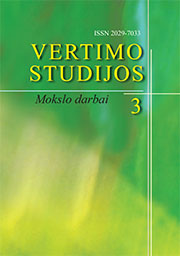KALBOS TEMPO IR SINCHRONINIO VERTIMO KOKYBĖS SĄVEIKA
THE RELATION BETWEEN THE SPEECH DELIVERY RATE AND QUALITY IN SIMULTANEOUS INTERPRETATION
Author(s): Viktorija Noreikaitė, Alina DailidėnaitėSubject(s): Evaluation research, Translation Studies
Published by: Vilniaus Universiteto Leidykla
Keywords: Interpretation; Speech delivery rate; Speaker;
Summary/Abstract: The main aim of every interpreter is to be precise and fluent in delivering the message of the speaker. This task is a tough one, bearing in mind all the additional difficulties that an interpreter has to face. This article attempts to find out how one of such difficulties—the speech delivery rate—affects the quality of simultaneous interpretation from English into Lithuanian. All target texts were analysed from the viewpoint of the accuracy of the meaning conveyed in the interpretation, and then from the viewpoint of the fluency of the delivery. The impact of the source text delivery rate on quality in simultaneous interpretation was examined by carrying out an experiment, in which two speeches, read at low and high rate were interpreted by 6 students. A quantitative and an accurate qualitative analysis of the results show that fast source text delivery rate has a negative impact on interpreters’ performances in terms of meaning conveyed in the interpretation. In this instance, interpreters tend to make more omissions than is the case when they are interpreting the speech of a moderate delivery rate. Results varied with regard to the effect on interpretations in terms of fluency: some interpretations were more fluent than others. This depended on the interpreter’s abilities, applied strategies and prior experience in simultaneous interpreting. This experimental study revealed the main reasons why it was more difficult for interpreters to interpret the speech delivered at a fast rate. The article identifies the problems of effort coordination, lagging too far behind the speaker, transcoding, and the lack of the ability to summarise.
Journal: Vertimo studijos
- Issue Year: 3/2010
- Issue No: 3
- Page Range: 9-22
- Page Count: 14
- Language: Lithuanian

